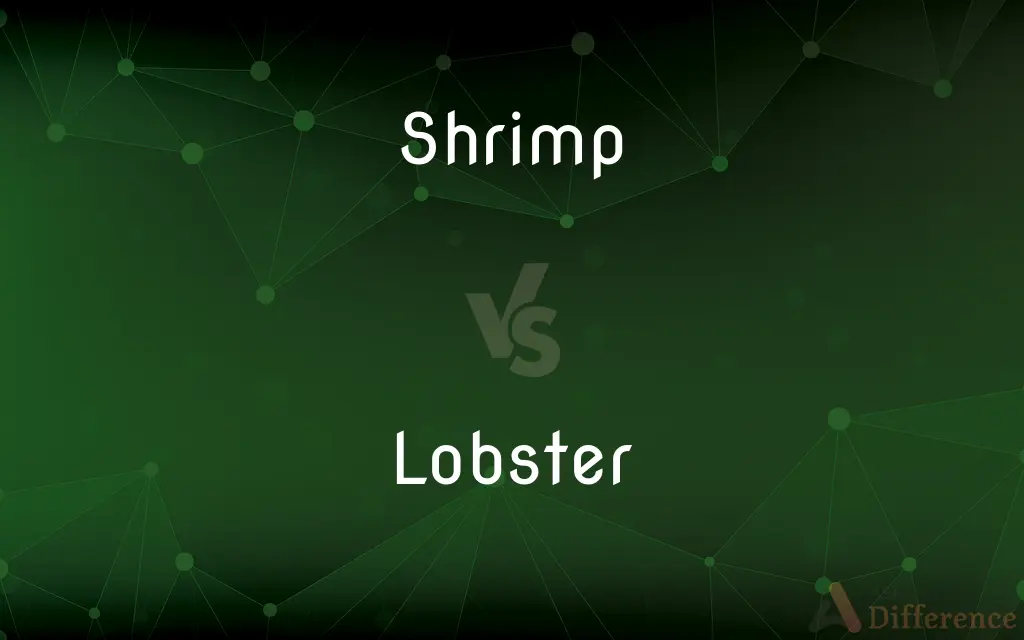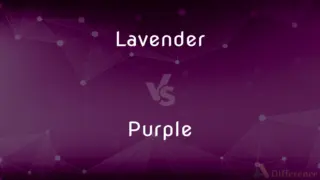Shrimp vs. Lobster — What's the Difference?
Edited by Tayyaba Rehman — By Urooj Arif — Updated on March 15, 2024
Shrimp are small, abundant seafood with a flexible exoskeleton, often eaten whole, while lobsters are larger, prized for their claws and tail meat.

Difference Between Shrimp and Lobster
Table of Contents
ADVERTISEMENT
Key Differences
Shrimp are small crustaceans with a distinct bend in their bodies, primarily harvested for their whole body. They are known for their quick cooking time and delicate flavor. On the other hand, lobsters are much larger, offering more substantial meat primarily in their claws and tails. Their cooking time is longer due to their size, and they boast a richer, more robust flavor.
Shrimp are found in both freshwater and saltwater environments and are more widely available due to their abundance and ease of farming. This makes them a staple seafood across various cuisines globally. Whereas lobsters are typically found in colder, saltwater environments and are considered more of a delicacy, leading to a higher market price.
The preparation methods for shrimp often involve peeling and deveining before cooking, which is relatively simple due to their small size. Lobsters, however, require more effort in preparation, including boiling or steaming whole before extracting the meat from the shell, especially from the claws and tail.
Shrimp are low in calories and fat but high in cholesterol, making them a good protein choice in moderation. Lobsters, while also rich in protein, tend to have a higher fat content, especially when consumed with butter, a common accompaniment.
In culinary applications, shrimp are versatile, used in everything from salads and pasta to curries and tacos. Lobsters, while also versatile, are often featured in more luxurious dishes, such as lobster bisque, lobster rolls, or simply served steamed with butter.
ADVERTISEMENT
Comparison Chart
Size
Small, ranging from 1 to 8 inches
Large, often 8 inches to more than 20 inches
Habitat
Both freshwater and saltwater
Primarily saltwater, colder regions
Market Price
Generally lower, widely available
Higher, considered a delicacy
Preparation
Quick, simple (peeling and deveining)
More complex (boiling, extracting meat)
Culinary Uses
Versatile, used in various dishes
Featured in luxurious dishes
Compare with Definitions
Shrimp
Can be cooked in various ways, including boiling, grilling, and frying.
We grilled the shrimp for the barbecue tonight.
Lobster
Requires boiling or steaming whole before meat extraction.
We steamed the lobster for 20 minutes before cracking it open.
Shrimp
Harvested from both wild fisheries and aquaculture.
The shrimp in this dish were sustainably farmed.
Lobster
More expensive than many other types of seafood due to its size and taste.
The restaurant's lobster dish is a pricey, but delicious, option.
Shrimp
A small, decapod crustacean with a flexible exoskeleton, widely consumed as seafood.
Shrimp are often added to pasta and salads for a protein boost.
Lobster
A large marine crustacean known for its meaty claws and tail.
Lobster is often considered a luxury seafood choice.
Shrimp
Known for their sweet, mild flavor, making them a favorite in culinary applications.
The chef seasoned the shrimp lightly to preserve their natural taste.
Lobster
Prized for its rich, sweet meat, especially in the claws and tail.
The lobster tail was cooked to perfection, revealing its succulent meat.
Shrimp
Available in various sizes and types, affecting their flavor and texture.
The recipe calls for large tiger shrimp for the best outcome.
Lobster
Considered a delicacy in many cuisines, often served with butter.
For dinner, we had lobster with melted butter on the side.
Shrimp
Shrimp are decapod crustaceans with elongated bodies and a primarily swimming mode of locomotion – most commonly Caridea and Dendrobranchiata. More narrow definitions may be restricted to Caridea, to smaller species of either group or to only the marine species.
Lobster
Lobsters are a family (Nephropidae, sometimes also Homeridae) of large marine crustaceans. Lobsters have long bodies with muscular tails, and live in crevices or burrows on the sea floor.
Shrimp
Any of various small, chiefly marine, often edible decapod crustaceans that have a laterally compressed, elongated body with long antennae and long legs used for swimming. The shrimps include species belonging to the superfamily Penaeoidea of the suborder Dendrobranchiata and to the infraorder Caridea of the suborder Pleocyemata.
Lobster
Any of several edible marine decapod crustaceans of the family Nephropidae, especially of the genus Homarus, having stalked eyes, long antennae, a pair of large pincers, and a cylindrical body.
Shrimp
The flesh of one of these crustaceans, used as food.
Lobster
Any of several similar crustaceans, such as a spiny lobster.
Shrimp
Any of various similar crustaceans, such as a fairy shrimp.
Lobster
The flesh of a lobster used as food.
Shrimp
Derogatory Slang A person who is small in stature.
Lobster
To catch or try to catch lobsters.
Shrimp
To fish for shrimp.
Lobster
Red-colored, especially from a sunburn.
Red as a lobster
Shrimp
Any of many swimming, often edible, crustaceans, chiefly of the infraorder Caridea or the suborder Dendrobranchiata, with slender legs, long whiskers and a long abdomen.
Lobster
A crustacean of the Nephropidae family, dark green or blue-black in colour turning bright red when cooked, with a hard shell and claws, which is used as a seafood.
Shrimp
(uncountable) The flesh of such crustaceans.
Lobster
A crustacean of the Palinuridae family, pinkish red in colour, with a hard, spiny shell but no claws, which is used as a seafood.
Shrimp
(slang) A small, puny or unimportant person.
Lobster
A soldier or officer of the imperial British Army (due to their red or scarlet uniform).
Shrimp
Synonym of butterface: a person with an attractive body but unattractive face.
Lobster
(slang) An Australian twenty dollar note, due to its reddish-orange colour.
Shrimp
(intransitive) To fish for shrimp.
Lobster
To fish for lobsters.
Shrimp
To contract; to shrink.
Lobster
Any large macrurous crustacean used as food, esp. those of the genus Homarus; as the American lobster (Homarus Americanus), and the European lobster (Homarus vulgaris). The Norwegian lobster (Nephrops Norvegicus) is similar in form. All these have a pair of large unequal claws. The spiny lobsters of more southern waters, belonging to Palinurus, Panulirus, and allied genera, have no large claws. The fresh-water crayfishes are sometimes called lobsters.
Shrimp
To contract; to shrink.
Lobster
As a term of opprobrium or contempt: A gullible, awkward, bungling, or undesirable person.
Shrimp
Any one of numerous species of macruran Crustacea belonging to Crangon and various allied genera, having a slender body and long legs. Many of them are used as food. The larger kinds are called also prawns. See Illust. of Decapoda.
Lobster
Flesh of a lobster
Shrimp
Figuratively, a little wrinkled man; a dwarf; - in contempt.
This weak and writhled shrimp.
Lobster
Any of several edible marine crustaceans of the families Homaridae and Nephropsidae and Palinuridae
Shrimp
Disparaging terms for small people
Shrimp
Any of various edible decapod crustaceans
Shrimp
Small slender-bodied chiefly marine decapod crustaceans with a long tail and single pair of pincers; many species are edible
Shrimp
Fish for shrimp
Common Curiosities
Can you eat the whole shrimp?
Yes, shrimp can often be eaten whole, though peeling and deveining are common preparatory steps.
What part of the lobster is most valued?
The claws and tail of the lobster are most prized for their meat.
Why are lobsters more expensive than shrimp?
Lobsters are considered a delicacy, larger, and not as widely available as shrimp, contributing to their higher price.
What makes lobster a luxury seafood?
Its larger size, taste, and the effort required to prepare it make lobster a luxury seafood.
What are the main differences in habitat between shrimp and lobster?
Shrimp can be found in both freshwater and saltwater environments, while lobsters primarily inhabit colder, saltwater regions.
How do shrimp and lobster differ in taste?
Shrimp have a delicate, sweet flavor, while lobster offers a richer, more robust taste.
How does the preparation of shrimp and lobster differ?
Shrimp preparation is simpler, involving peeling and deveining, while lobster requires boiling or steaming and extracting meat.
Are shrimp and lobster served in similar dishes?
While both can be used in a variety of dishes, lobsters are often reserved for more luxurious presentations.
Which is more versatile in cooking, shrimp or lobster?
Shrimp are more versatile due to their size and ease of preparation, used in a wide array of dishes.
Can shrimp and lobster be farmed?
Yes, both can be farmed, but shrimp farming is more common due to their smaller size and shorter lifecycle.
Are there different ways to cook shrimp and lobster?
Yes, shrimp can be boiled, grilled, fried, etc., while lobster is typically boiled or steamed whole.
Is there a nutritional difference between shrimp and lobster?
Both are good sources of protein; shrimp is lower in calories but high in cholesterol, whereas lobster can be higher in fat.
Do shrimp and lobster have the same texture?
No, shrimp tend to have a softer texture, while lobster meat is firmer and meatier.
Why are shrimp considered a staple in many cuisines?
Their wide availability, affordability, and versatility make them a staple in diverse culinary traditions.
What are common methods of serving lobster?
Lobster is commonly served steamed or boiled with butter, in rolls, or in bisques.
Share Your Discovery

Previous Comparison
Lavender vs. Purple
Next Comparison
Human vs. MachineAuthor Spotlight
Written by
Urooj ArifUrooj is a skilled content writer at Ask Difference, known for her exceptional ability to simplify complex topics into engaging and informative content. With a passion for research and a flair for clear, concise writing, she consistently delivers articles that resonate with our diverse audience.
Edited by
Tayyaba RehmanTayyaba Rehman is a distinguished writer, currently serving as a primary contributor to askdifference.com. As a researcher in semantics and etymology, Tayyaba's passion for the complexity of languages and their distinctions has found a perfect home on the platform. Tayyaba delves into the intricacies of language, distinguishing between commonly confused words and phrases, thereby providing clarity for readers worldwide.















































